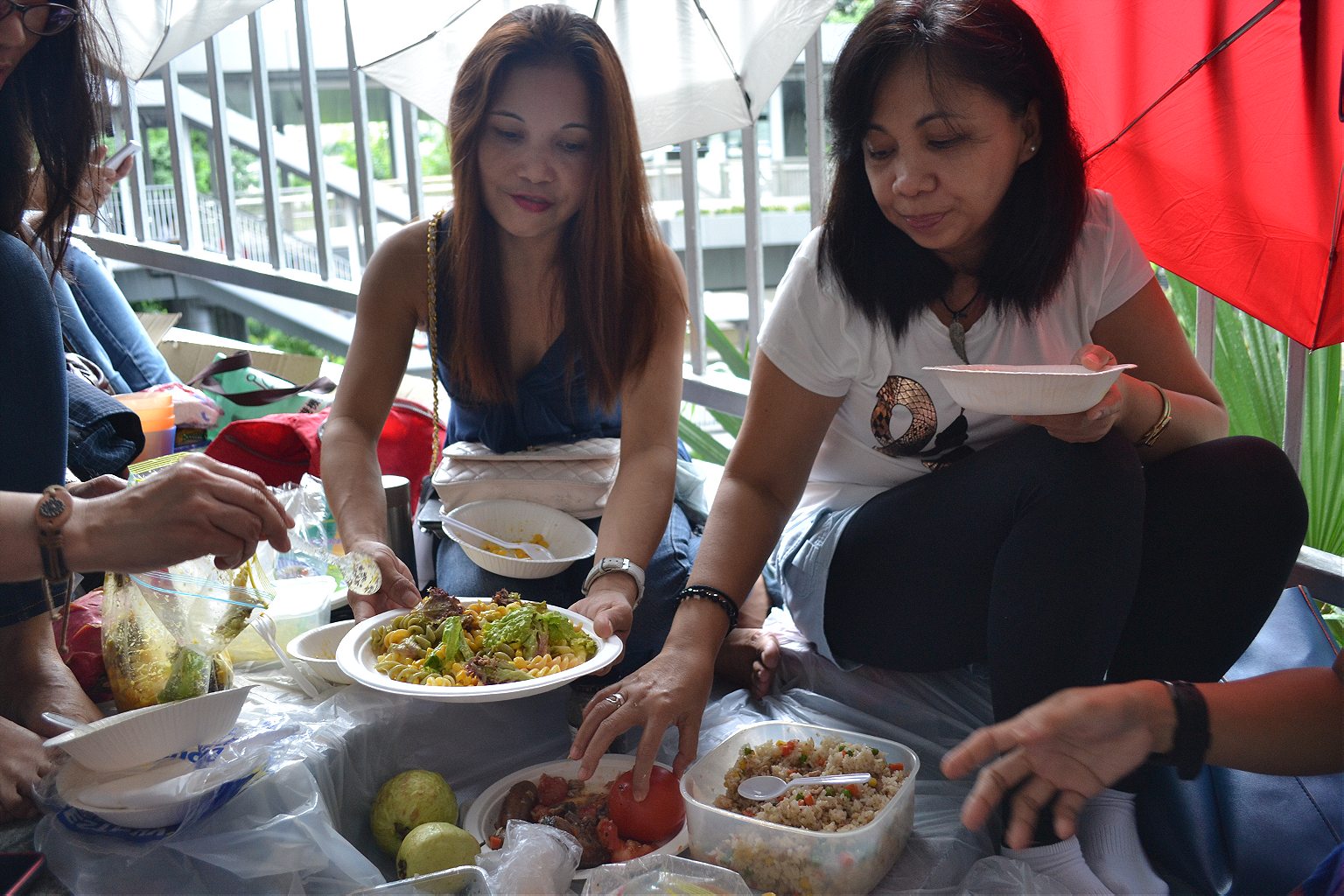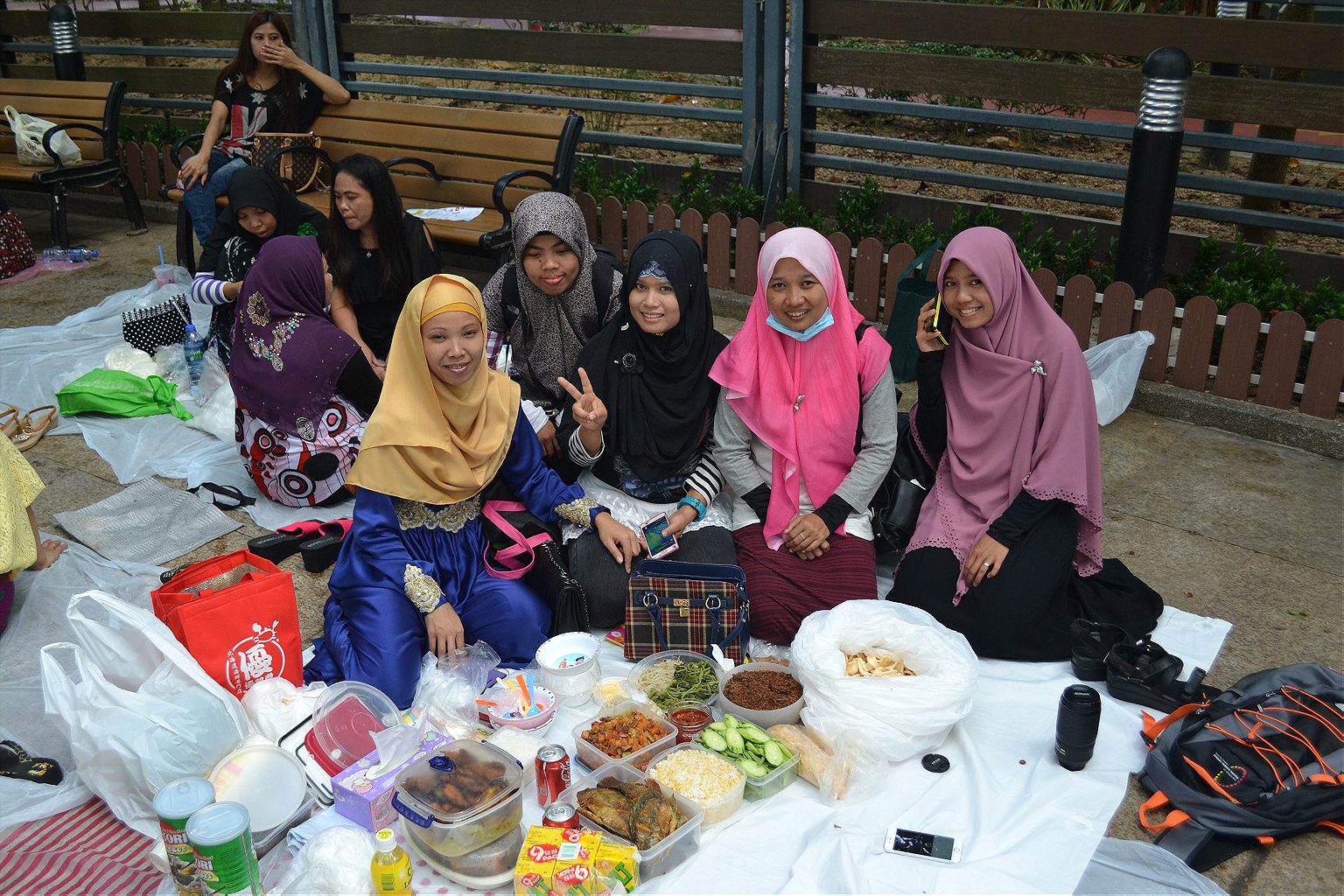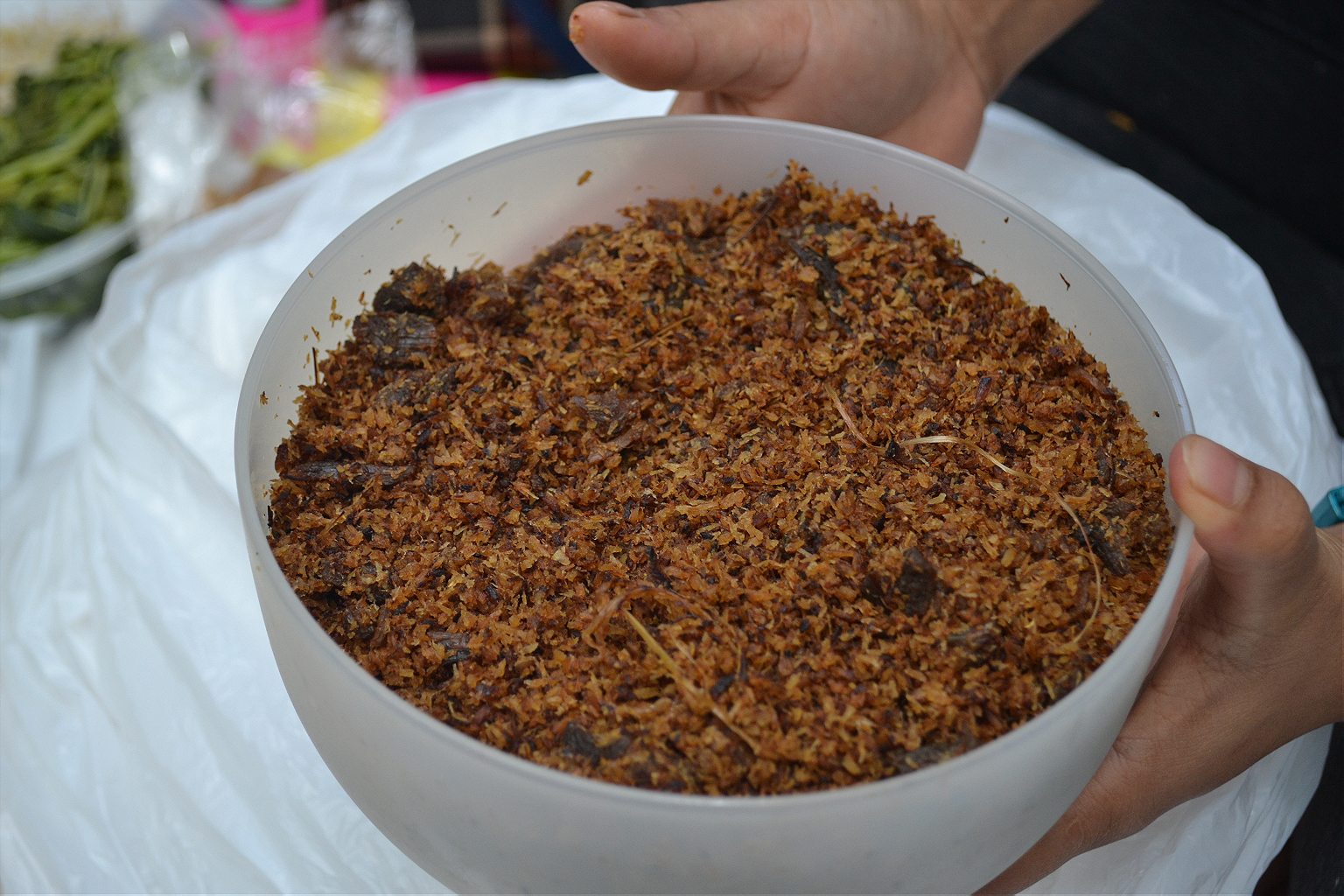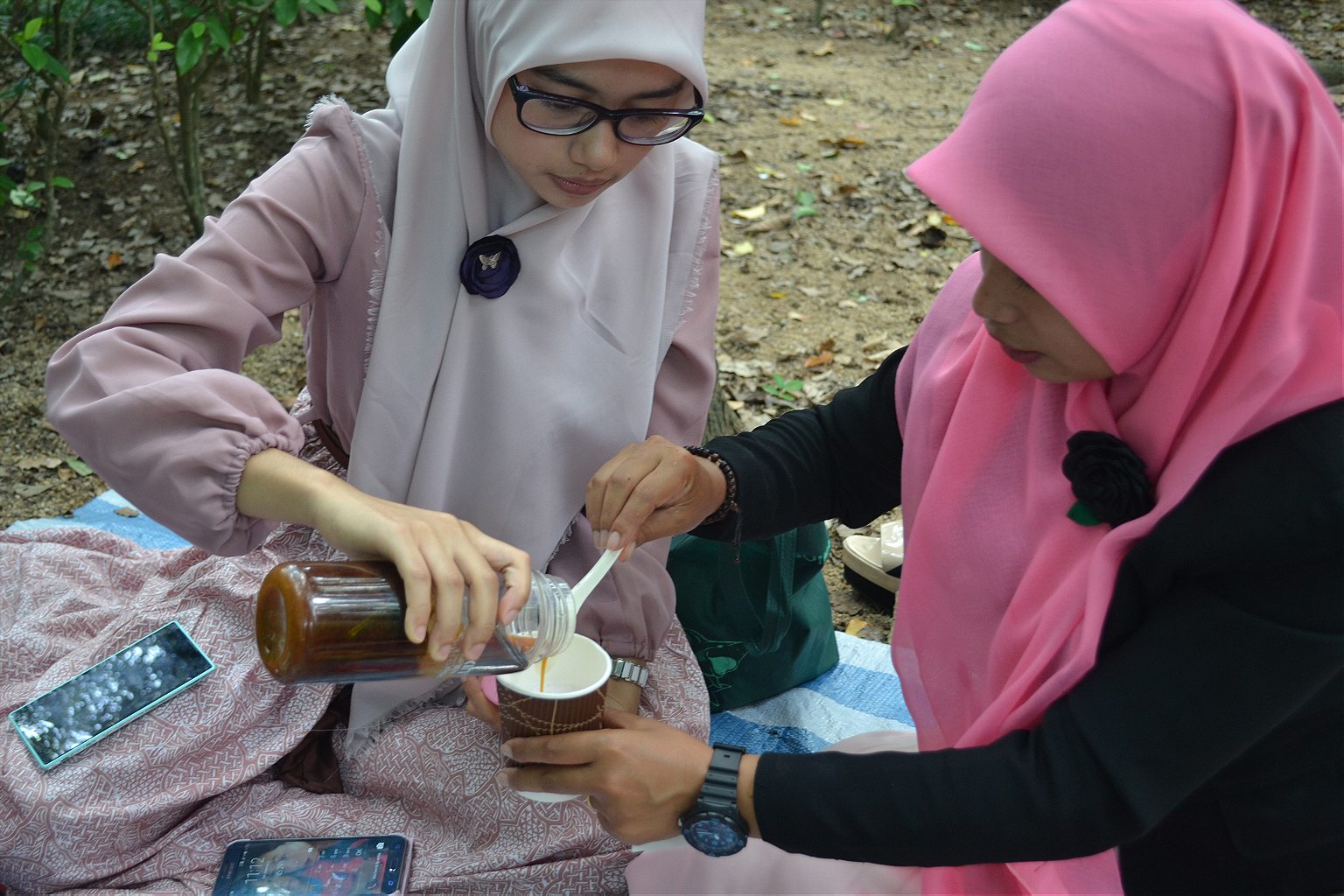Hong Kong’s Filipino and Indonesian domestic workers meet on walkways and under flyovers to share food from home.
It’s a response common to people around the world who don’t have much. When a stranger arrives, Abhie immediately and instinctively offers him a seat and a plate of food. The seat is a flattened blue shopping bag that acts as a thin cushion from the concrete. The plastic plate is quickly filled with aromatic pork adobo, fried rice and a hash of egg, onion and tomato.
We eat and talk as traffic thunders past beneath us, locals wandering past without a glance, occasional bemused looks from tourists. Then comes the rain. When you’re outside for ten hours in 85-degree heat and 87% humidity, you’re wet even before it starts raining. When it does begin to fall, there’s no cover other than cheap and flimsy umbrellas, wedged awkwardly in between railings or ineffectively taped to pillars.
The lucky ones staked their claim early, prime real estate where concrete flyovers and elevated walkways provide vague protection from whatever the elements decide to throw down that day. Outside, there’s no air conditioning in the brutal, relentless heat of summer, no warmth in the surprisingly cold winters. This is how 300,000 women spend every Sunday of the year, sitting in the streets of Hong Kong, eating from plastic boxes and looking up at the skyline of famous multi-billion dollar skyscrapers.

These women – they’re almost all women – are ‘foreign domestic helpers,’ their nationalities split equally between Filipinas and Indonesians. The commonly used term ‘helper’ is too benign, however. The reality faced by many of these women is far, far starker. They’re workers. Serious, hard workers. They’re required by law to live in their employer’s already-cramped residences from where they redefine multi-tasking: cooking, childcare, cleaning, laundry and much more, often for 18 hours a day, six days a week. All for HKD 4,110: about $530 a month.
Sunday is the one day in the week – the only day – that they get to rest. On Hong Kong Island the Filipino helpers congregate in and around Central, the city’s commercial and tourist heart, while the Indonesians favor Causeway Bay around Victoria Park. Impromptu nail salons and hairdressers, Koran study groups, dance workshops, card games and bingo all spring up for a few brief hours. But above all, it’s the food.

For the vast majority it’s the one time in the week when they get to eat food from their home country. A simple stew or humble fried fish takes on huge symbolic and emotional resonance, another reminder of a family far away. Many of these women are also mothers. They see their partners and children for just two weeks every two years.
Halfway down a spiral concrete stairwell, underneath a parking lot adjacent to some of the world’s most expensive real estate, sit four friends: Rochelle, Precious, Elluena and Abhie.
We – my wife and I – approach them and start to explain that we’re interested in what they’re eating. Seats and plates are offered before we finish our sentence. They explain that they’re from different parts of the Philippines’ seven thousand islands. They meet up to share their food, catch up on gossip – chismis in the country’s Tagalog language – and study the bible. No one decides what to bring in advance: after years of meeting up, they have a sixth sense of what is needed.
Their first tub contains Longganisa, chorizo-like sausages. Countless local versions are made around the Philippines, generally they’re either sweet, matamis, or garlicky: mabawang. Here they’re the former, fried off with tomatoes and tambakol fish that soak up the sweet, smoky oil.

No Filipino meal can be served without some form of adobo, the slow-cooked national dish of pork or chicken marinated in soy sauce, vinegar, peppercorns and bay leaves. Every Filipino’s version is slightly tweaked and Rochelle’s is somehow both dark and glistening all at once, less sauce than usual, the fatty cuts rich with umami from the soy.
The food is, at best, lukewarm. There’s no source of heat to cook on, just aluminum foil and tightly sealed plastic to try and retain some warmth.
To accompany the meat dishes, a fusilli pasta salad made by Precious, with mango, eggs, mayonnaise, black pepper, lettuce and vinaigrette. There’s also, fried rice with minced pork and garlic, more egg with tomatoes and a jar of potent homemade chili sauce. They finish the fine meal with a quartet of knobbly guava fruit. Every dish is shared, as are any leftovers.
A couple blocks away, past the women huddling together from the rain outside Saint Laurent and Gucci, a group sit on flattened cardboard boxes just a few yards from the entrance of Two International Finance Centre, a comically phallic tower that is home to countless trading floors.

Their plastic tubs of food are bigger and neatly arranged. Arlene is introduced as the ‘queen of adobo’, much to her embarrassment and the amusement of her friends. It’s also her birthday. Arlene’s secret is to add banana blossom, mushrooms, black beans and a spoonful of sugar to the pan, before leaving it stew overnight. It’s served with rice and a huge box of pancit, the ever-popular fried noodle dish.
The lady responsible for the pinakbet comes from the northern Philippines. It’s one of her region’s most popular dishes, vegetables steamed in shrimp sauce: bitter melon, okra, eggplant, tomato and winged beans all feature, along with nuggets of fatty pork. You’re never far from pork in the Philippines. Or in Hong Kong on a rainy, sultry Sunday in August.


Dessert isn’t forgotten. Buko pandan fruit salad is a terrifyingly day glow-green solid wedge of young coconut meat and tinned fruit cocktail encased in pandan jelly and condensed milk. To wash down the modest feast, there are huge bottles of Sprite and tooth-achingly sweet mango juice.
The final touch, from a late arrival, a plastic bag of Jollibee takeaway. Jollibee is the most popular fast food chain in the Philippines. In Hong Kong, one branch caters for the city’s 140,000 Filipinos. Just don’t try going on a Sunday. A beaming, demonic cartoon bee brands the packaging of the Chickenjoy and Jollee Spag: a grim-looking concoction of spaghetti, tomato sauce, sugar and slices of hotdog.
Arlene and Ann are from the island of Cebu, the home of lechon, the slow roast pig that many feel is the world’s best. The welcome is warm and immediate, Arlene explaining with an infectious laugh that she is the “yummy mummy,” while her close friend Ann is “single to mingle.” Arlene has three teenage kids, one of whom is set to graduate this year and go on to university. Her pride couldn’t be any clearer. Once every two years, when her contract finishes, Arlene gets to spend two or three weeks at home with her children. It’s the only time she sees them, other than on Skype.
Arlene is estranged from her husband, and sends money back home every month to look after her children, via her mother. Together, the country’s two million OFWs – ‘overseas Filipino workers’ – contribute billions of dollars annually to the Philippine economy, a critical lifeline.
In common with a number of domestic workers, Arlene isn’t allowed to cook at home because, extraordinarily, the family she lives with “Don’t want me to waste energy.” So she has to buy food from outside, at cheap dai pai dongfood stalls. Luckily this week the family was away on vacation, so she had time alone in the kitchen. She made the most of the opportunity.

On a plastic sheet with counterfeit Mickey Mouse branding, sits her Guisadong itlog. A mouthful to pronounce, it’s a mix of sautéed egg with tomatoes, onions and black pepper. There’s more egg, cooked in a dish of string beans and garlic, while another Filipino favorite – Spam – makes an appearance alongside fried pork chops and fish. To finish, another tub of an intriguing and very Filipino mix of pineapple, watermelon, apple, guava, cranberries, and cubes of Kraft cheese.
While there are a number of small Filipino food stores in Hong Kong, Arlene and Ann explain that the food they miss most from home is “Real adobo and real lechon” along with shrimp paste called Bagoong – a Pinoy staple added to almost any dish – and their beloved condiment of vinegar infused with small labuyo chilies.
The following Sunday my wife and I head to Victoria Park in the center of Hong Kong island. In typical Hong Kong fashion there’s far more concrete than grass or greenery, meaning the blazing sunshine and ninety-degree heat is even more unforgiving for the thousands of Indonesian women meeting there. Their country’s cuisine is as underrated as their northern neighbor in the Philippines. With 3000 ethnic groups and more than 250 million people on 17,000 islands, culinary generalizations are pointless.
Indeed, the women we meet come from all over the vast nation, with different dishes and flavors at every turn. The frequency and levels of spices and fresh herbs are ratcheted up, with some small groups sharing a mortar and pestle to grind pastes, often with coconut or peanut. The Spice Islands towards the east of the country are famous for introducing nutmeg, mace and clove to the world, but here in Causeway Bay it’s chili which is undeniably king.

Five friends from Indonesia’s main island of Java are resplendent in multi-colored hijabs and veils, a riot of color and flowing fabrics. They explain that they’re not allowed to wear their traditional dress during the week, before adding that it’s also not exactly practical to do so when washing piles of dishes and changing diapers.
Their spread includes Nasi jagung or corn rice, originating in parts of the country where rice is expensive and dried corn can help bulk up the plate. Ikan goreng is a generic term for fish or seafood that is marinated in spices and then fried.


A bowl of fried desiccated coconut with beef and chili is wonderful, like the building blocks of a beef rendang, while Baso are beef balls with tapioca flour, a street food snack that US President Barack Obama recalled with fondness when giving a speech at the University of Indonesia in Jakarta.
It’s those spices that truly take center stage, however. Green beans, potatoes, chopped liver and pancreas – gently renamed ‘sweetbreads’ across Hong Kong’s myriad of Michelin-starred restaurants – are laced with fresh chilies even before the chef adds sambal kecap.
Kecap is the Indonesian word for sauce – and also the derivation of ketchup. Inside a jar which once held Korean Gochujang chili paste, sits a truly volcanic homemade mix, the tiniest hint of which lasts about a minute on the palate. It’s extraordinary, multi-layered and far more subtle than it first appears. A variety of chili peppers vie with shrimp paste, fish sauce, garlic, ginger and vinegar as distinct constituent flavors. Sambal kecap is everything to these women and it graces every plate of their food, without fail. Slices of cucumber are token efforts to cool.
Another small group of friends, sitting under a bright red Flame tree in a quieter corner of the park, turn out to be cousins. Their spread is the definition of simple because: “We didn’t have time to cook.” You wouldn’t think so. Cold noodles sit waiting to be mixed with bottled chili sauce and mushroom kecap, while a fiery-looking chicken stew is enlivened further by fresh chopped red chilies and scallions.
The cousins insist I try a dessert called cendol. It’s a paper cup of ice (a precious commodity, delivered minutes before by a friend) with green jelly made from mung bean flour with pandan leaf coloring. Coconut milk from a jar is spooned on, before palm sugar juice is carefully added to the mixture. It is intoxicatedly good and the definition of refreshing on a scorching day.

Lina is the last person we speak to, and she is by far the busiest of all the domestic workers we’ve met. She’s busy because she is prepping a version of gado-gado, or Indonesian salad, for anyone who wants some. No money seems to be exchanged – she explains that she is just happy to make it for friends.
The process is remarkable, a blur of knife skills, pounding, grinding and tasting. Fresh ginger, garlic and chili is smashed into a sticky pulp with ground up peanuts, glugs of what looks like mushroom ketchup, sugar and salt. She drags the heavy black stone pestle across the mortar, kneading and cajoling the flavors into submission, all while perched on the kerb of a busy sidewalk.

Cabbage and thin green beans are chopped at dizzying speeds before being folded together with the sauce, her hands gently cupping the sides to ensure nothing falls off. The mixture is then spooned into triangular sheets of brown paper before she adds in small cubes of sticky rice and a couple of shrimp flavored crackers. She adds a white plastic spoon before she hands the package to me.
I hadn’t asked for any and certainly didn’t expect to taste any. It is sensational, vibrant, a symphony of flavors and textures that would shame the restaurants in the five star hotel across the road. It is also made on her only day off. She spends the rest of the week supporting a family of five from sunrise until late at night.
In common with the remarkable domestic workers we met across Hong Kong, Lina is a welcoming, warm-hearted and unfailingly generous woman. In a city where courtesy is not common currency, she and all the women we spoke to represent a timely, humbling and welcome change – as well as a reminder that the most memorable food is invariably served in the least likely of settings.